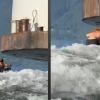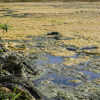Lower Similikameen Indian Band (LSIB)’s chief asked a mining executive to “present the facts and the truth” about waste spills from the Copper Mountain Mine as the company seeks to expand its operations in smǝlqmíx homelands.
During a community meeting last week, Keith Crow also reiterated that LSIB still “does not consent” to expanding the open-pit copper, gold and silver mine, which would include extending a tailings dam in the vicinity of the Similkameen River.
Project owner Hudbay Minerals is pushing to restart the Ingerbelle Pit, an old part of the mine, to extend the mine’s lifespan — which Crow said his community still “does not consent” to during a community meeting on June 12 with company officials.
“It sounds like you’re moving forward already with the Ingerbelle,” Crow said.
“We haven’t approved yet. So what does that mean? I’m asking that question because we haven’t fully endorsed or approved — but you’re moving forward.”
.jpg)
The mining company held a separate meeting with Upper Similkameen Indian Band (USIB) earlier the same week.
Toronto-based Hudbay Minerals bought the project in 2023, and became the project’s sole owner this year. It extracts more than 45,000 tonnes of copper a year from the mine, about 20 kilometres south of Princeton, BC.
Crow’s comments came after executives with Hudbay gave LSIB members an update on details of their revised expansion application.
Mine released unauthorized waste last month
But the tensest moments at the Hudbay meeting occurred when a resident asked about mine waste spills in smǝlqmíx homelands.
The meeting took place less than a month after the mine released waste twice without government approval — with two unauthorized discharges a week apart, on May 22 and May 29, according to the province.
The BC Ministry of Environment and Parks told IndigiNews that the May 22 incident — caused by a pump failure — dumped about 3,000 litres of mine tailings waste into an area beside the Similkameen River.
The province said it’s unknown if the waste entered the river or was absorbed into the ground.
“It is unlikely that it reached the river, but due to the area’s difficult terrain and dense vegetation, it cannot be known with certainty,” said a provincial spokesperson in a statement.
One week later, during maintenance work on a seepage collection ditch to the mine’s east by Copper Mountain Road, a pipe failed and released even more into the environment — about 5,600 litres of mine contact water, the province estimated.
“This area is not located near the Similkameen River,” said the spokesperson.
“Both unauthorized discharges have been determined to be low risk to human or environmental health based on the volume, duration, and characteristics of the discharges.”
For LSIB’s Crow, these two incidents “reconfirmed why” there’s pushback on the project within his community.
But when a community member asked John Ritter, vice-president of Hudbay’s BC business unit, about any spills from the mine in recent years, he replied that there were only six reported unauthorized mine spills since 2016.
“That is not correct, that’s a lie. I’ll say that flat out,” Crow said, alleging the mine had more than six unauthorized discharge or spill events in that timeframe.
“I want the truth and I want the facts. Please present the facts and the truth. And if you don’t, I will.”
At the meeting, Ritter clarified that he “meant releases, spills reported to the government,” acknowledging that “there’s a lot more releases” beyond what’s reported to the province.
In an email to IndigiNews, Ritter said there was “some misunderstanding” regarding his response to the question about spills at the mine.
According to Ritter, mine spills are tracked in two categories. Category one spills are “reported releases or exceedances that received administrative penalties.”
Meanwhile, category two spills are “reported releases or exceedances that did not result in administrative penalties.”
Since 2016, there have been seven category one spills and 51 category two spills, he said.
“During the meeting, I was specifically referencing category one incidents. Based on the information I had at the time, I cited six unauthorized releases. After reviewing additional data this morning, I can confirm the correct number is seven,” Ritter said in a June 19 email.
“However, Chief Crow was referring to both categories combined, and he is correct that the overall number is higher — which I acknowledged during the discussion.”
He added that “transparency and environment stewardship” are among the mine’s top priorities.
“We report all spills — regardless of whether they are formally reportable to the ministry to ensure we can identify root causes and implement effective mitigation measures to prevent recurrence,” he said.
“Finally, I would like to note that Chief Crow and I had a respectful and constructive discussion regarding continuing to work collaboratively on this important topic moving forward.”
In 2024, the provincial Ministry of Environment and Climate Change Strategy issued six fines to Copper Mountain Mine totalling $105,348.
The string of offences, which occurred between 2019-2022, all relate to the mine’s unauthorized seepage and discharge of toxic waste from its tailings pond into the surrounding waterways of the Similkameen River and Wolfe Creek.
In 2021, the mine at one point exceeded the legal limit of copper waste discharged from its tailings pond into Wolfe Creek by more than 4,500 per cent.
‘We have a lot of work to do,’ says mine VP
Hudbay submitted its revised application in March, which is now being considered by the province’s Mine Review Committee, as well as USIB and LSIB. A technical review of the proposal is also expected to go through several rounds of evaluations this summer and fall.
“I just want to be clear, at this moment, we do not consent,” Crow said. “We have more work to do to get to that point. And then we have to provide that information to our members, and take it to a vote.”
The LSIB leader added that, if and when his community decides to vote on the mine expansion, “If it’s a no, it’s a no,” he warned.
“We have to stand behind that — but if it’s a yes, it’s a yes, and we move forward. But there’s a lot for us to get to that point.”
While a potential community vote wouldn’t take place until later this year, Crow said Hudbay has “major hurdles” to go through if it wants to get either communities’ approval.
“There’s a long way for them to go,” he said.
Ritter said getting the First Nation’s approval of the proposal is a “consent-based process.”
If the community votes against it, he said, the company has a “dispute resolution mechanism” within its process.
“So it would go to the dispute resolution,” he said, “and then from there we’ll see what happens.”
Located on smǝlqmíx homelands in syilx territory, the area now known as Copper Mountain Mine has seen mining operations since 1923.
Different companies have passed around ownership of the project throughout the last century, with the mine experiencing intervals of on-and-off activity.
During the June 12 company presentation, Ritter and other Hudbay staff detailed what the approved revival of the Ingerbelle Pit would entail for the mine’s operations.
“We’re trying to press here that we’re not finished,” Ritter said. “I don’t want to give the impression that we are finished — we have a lot of work to do.”
Expanding the mine would not create any new mill or processing facility, he said, but the existing tailings management facility would need to be expanded.
LSIB, USIB and several conservation groups have all called on the provincial government to order an environmental assessment for the mine expansion — citing concerns about its size, towering tailings dam, and proximity to the Similkameen River.
But the province decided last year that no such review is required.
‘Open for business’
Hudbay also plans to build a bridge over the Similkameen River to connect the Ingerbelle Pit to the rest of its mine operation, as well as new water management infrastructure to collect surface water leaving the mine site from the Ingerbelle Pit.
Ritter also revealed Hudbay now has full ownership over the operation, after buying out Japanese giant Mitsubishi Materials’ 25 per cent share of the project.
“That really gives us a lot more control,” said Ritter. “We don’t need to ask for permission.”
If the Ingerbelle proposal is approved, the New Ingerbelle project would add 10 years of mining to the overall operation, extending its life to 2037, according to Hudbay.
But if the proposal is rejected, mining operations could end as early as 2027, the firm said, although it could process low-grade ore for “several additional years.”
Asked if there are any entrepreneurship opportunities at the mine, Ritter said his company is “open for business.”
“[On] behalf of myself and the team, we are committed to working together,” he said. “We need your collaboration to make this a better project and journey very forward.”
Of the nearly 830 people employed at the mine, only 27 are members of either USIB or LSIB, according to Hudbay.
Ritter pointed to what he called the project’s “purpose statement,” which he described as “protect the people, the communities and the planet.”
But increasing the size of the mine’s tailings dam to accommodate the expansion remains a top concern for many in downriver First Nations.
In 2022, the Colville Confederated Tribes completed their own independent assessment of what might happen if the Copper Mountain Mine’s tailings dam were to fail.
According to the report, if a breach happened it “could release a debris flow” exceeding 10 metres deep, “several times greater than the largest flood ever recorded in the town of Princeton.”
Simulations conducted for the study estimated such a flow of debris would bring “life-threatening peak flows” to the town within just a few hours.
Asked about such concerns over possible fatalities from a potential dam breach, Ritter replied that “no people are going to die.”
Two public open-house meetings regarding Hudbay’s proposed Ingerbelle expansion will be hosted in USIB and LSIB next month, on July 8 and 9.
Aaron Hemens-Local Journalism Initiative Reporter-IndigiNews








.jpg)







